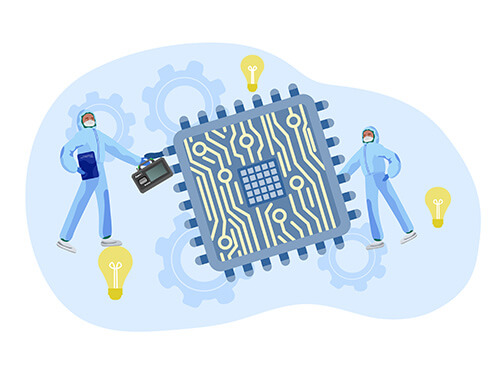Quality control in semiconductor manufacturing is superficially simple: create consistent quality products. That statement is easy enough to say, but incredibly difficult to truly implement. Quality control involves an in depth understanding of the products you are designing, the processes you have in place, and what can go wrong.
In a cleanroom, there are added layers of complexities to consider when it comes to quality control. Not only are you ensuring consistency in the products you create, but you have to ensure that they are not contaminated at a microscopic level. In semiconductor manufacturing, this microscopic contamination can lead to malfunctioning products.
In turn, malfunctioning products can result in recalls, damaged reputation, and a large financial hit. The best way to avoid this is to institute a solid environmental monitoring system (EMS) into your cleanroom. The basis of a good EMS are solid particle counters. These airborne particle counters can go a long way in helping enhance quality control in semiconductor manufacturing.
Real-Time Monitoring & Early Contamination Detection
When something goes wrong, you want to know right away. That is where real-time monitoring particle counters come in. Particle counters continuously monitor particle concentrations in cleanrooms or specific process areas where semiconductor manufacturing takes place. They provide real-time data on particle counts and sizes, allowing you to promptly detect any deviations from the required cleanliness standards. This real-time monitoring enables proactive decision-making and immediate corrective actions to maintain quality.
You can maximize this early detection by strategically designing your real-time monitoring system. Using your expertise, you can identify where the high risk areas are, as well as where contamination is most likely to enter the cleanroom. This could be from outside sources, such as through vents, or internal sources, like where there is a significant amount of human traffic or tools that could potentially shed particles.
Humans are a major contributor to contamination in cleanrooms. In fact, humans alone account for 75% to 85% of particles shed in a cleanroom. Every minute, we shed an average of 40,000 skin particles. Our skin, hair, and clothing generate roughly 100,000 particles 0.3 microns or larger per minute, but when we are moving, that number increases to over 5,000,000 particles.
Thus, to ensure your quality control stays in place during semiconductor manufacturing, strategically designing a real-time monitoring system to alert you at the earliest possible stage of contamination can prevent product damage.
Process & Cleanroom Validation
Validation is a critical piece of running a cleanroom, including monitoring quality control. Cleanrooms have to operate under sets of regulatory requirements, such as ISO 14644. This defines the standards cleanrooms need to meet to qualify for certain classifications. Other organizations might choose to pursue specific quality control certifications, such as ISO 14001, which provide evidence of consistent quality control measures.
Particle counters are a critical component in gathering the data needed to achieve these validations.
Root Cause Analysis
In case of product defects or quality issues, particle counters aid in root cause analysis. By comparing particle count data at different process stages, manufacturers can pinpoint the source and time of contamination. This analysis helps identify the specific equipment, procedures, or materials that contribute to particle generation or introduction, enabling targeted corrective actions to prevent future occurrences of similar defects.
Trend Analysis
Particle counters provide historical data on particle counts over time. By analyzing trends in particle levels, manufacturers can identify patterns and correlations with production parameters or environmental conditions. This analysis helps establish baseline levels and identify potential sources of particle contamination. By monitoring and analyzing trends, manufacturers can make data-driven decisions to optimize processes, reduce particle counts, and enhance overall quality control.
Documentation
Particle counters generate detailed reports and documentation of particle count measurements, so you can maintain a comprehensive record of quality control activities. These records serve as evidence of compliance with regulatory requirements, customer specifications, and industry standards. Documentation helps in audits, quality certifications, and customer audits, ensuring transparency and accountability in quality control processes.
How Should You Choose Your Particle Counter For Quality Control In Semiconductor Manufacturing?
Ultimately, particle counters go a long way in helping to improve quality control in semiconductor manufacturing, helping you avoid recalls and reputation damage. But where should you start when you are choosing a particle counter?
To start making your decision, you first need to decide what type of particle counter you need. There are three primary categories: handheld, portable, and remote.
Handheld particle counters are very small and handy, but they don’t have a vacuum so they work very slowly to get results. For this reason, they can be less accurate at times. In a pinch and in a small area, they can work, but for more serious or regular uses, there are better options.
Portable particle counters are the largest of the three options, but also the most versatile. They are designed to be moved around the cleanroom to get readings in different areas, which can help during validation. Models like LWS’ ApexZ are designed to be ergonomic with long-lasting batteries and lightning fast recharge speeds. Additionally, the ApexZ has an onboard touch screen so you can get your results without leaving the cleanroom.
Remote particle counters are small and designed to work in a web of particle counters. They are not designed to move and they don’t have a built-in screen. Instead, they send the information to an outside computer. Essentially, they are a permanent solution that works exceedingly well in an established system.
Once you determine the primary goal of your particle counters, you will want to look for one that has multiple connectivity options to adapt to systems you already have in place while being user friendly. You will also want to determine which classification your cleanroom needs to be and ensure your particle counter is capable of measuring particles at those sizes.
Here at LWS, we design top-of-the-line particle counters backed by aftermarket support and resources to help you make the most of your investment. Explore our options today.


